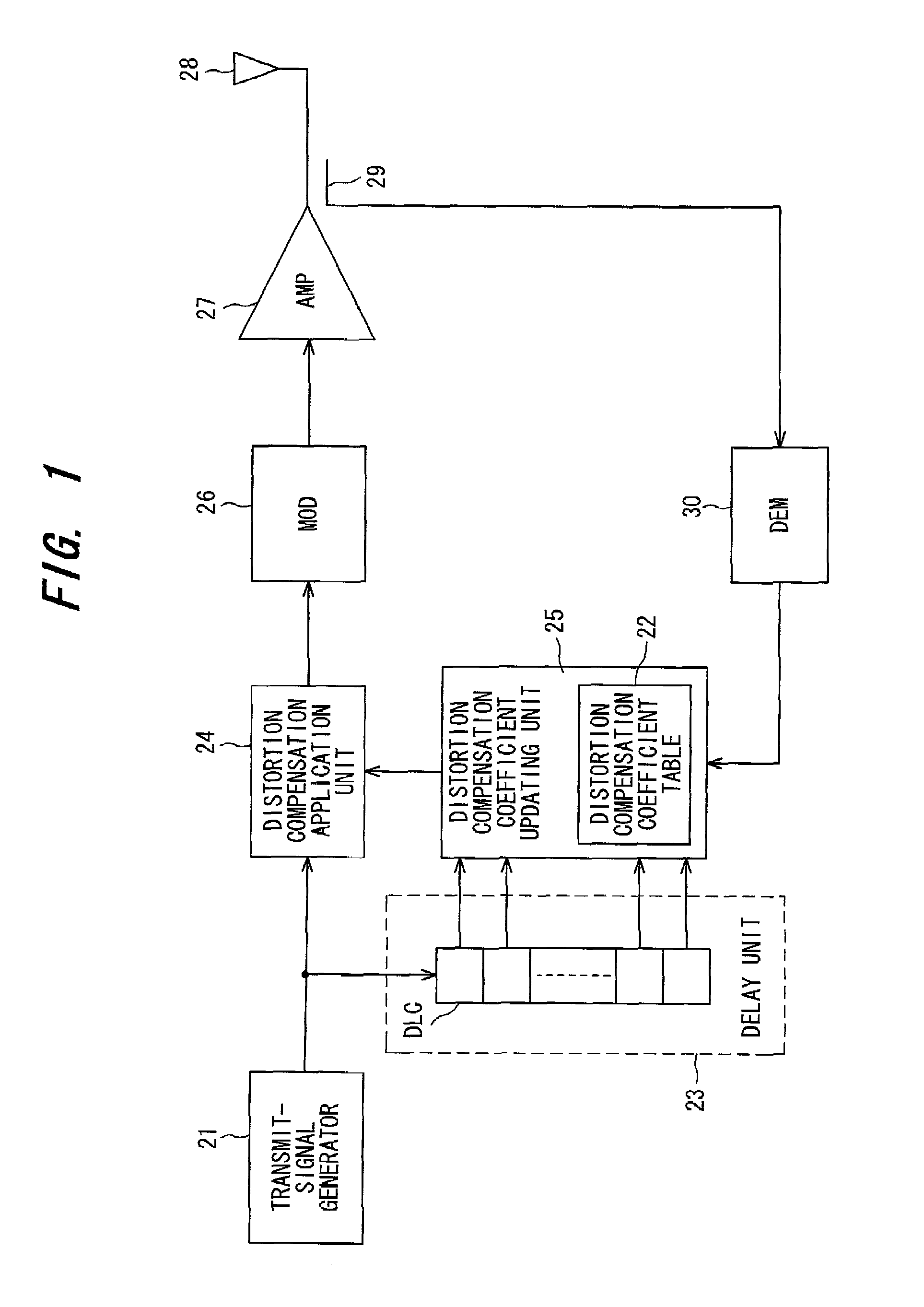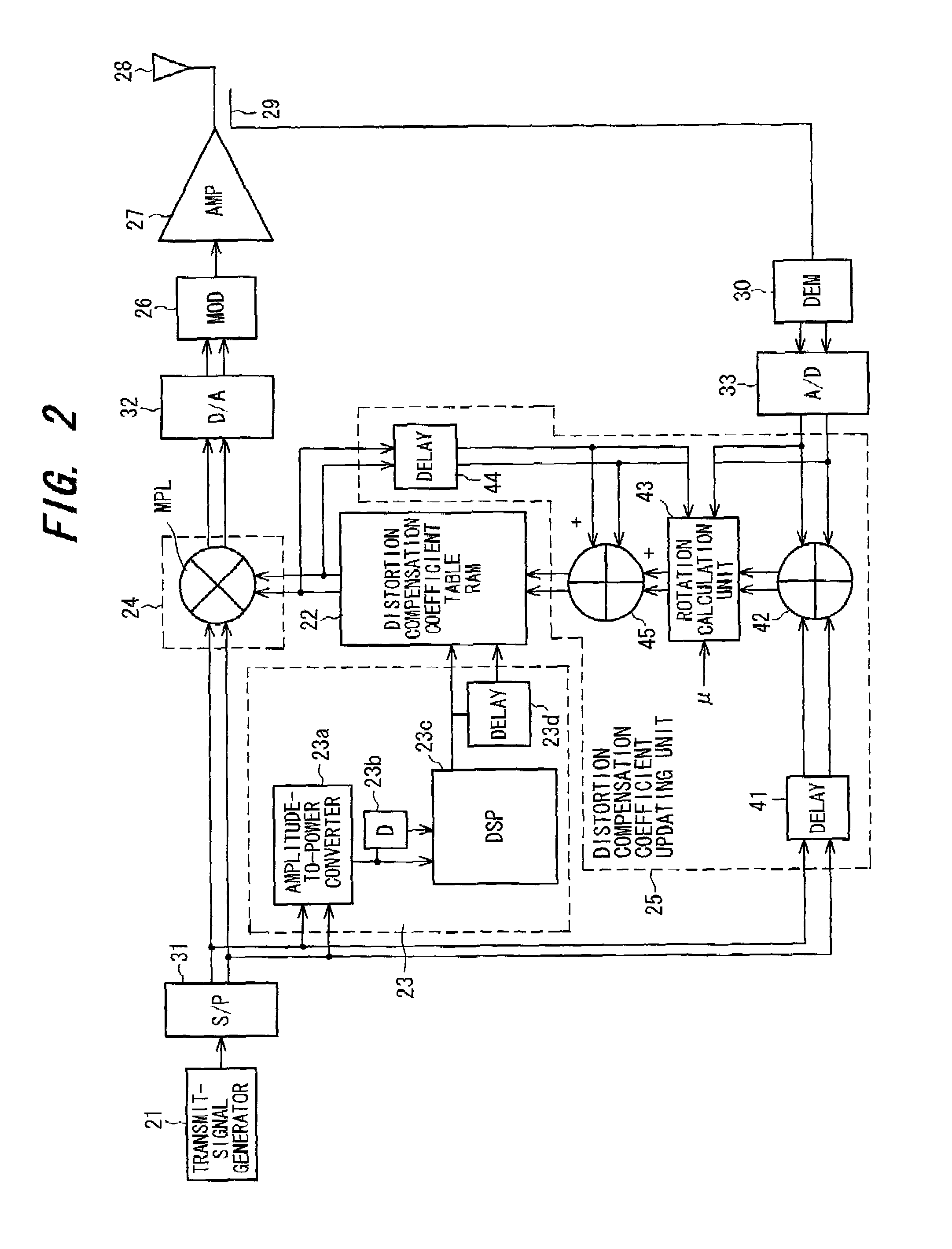Method and apparatus for compensating for distortion in radio apparatus
a radio apparatus and distortion compensation technology, applied in the direction of amplifier modification to reduce non-linear distortion, baseband system details, gain control, etc., can solve the problems of frequency asymmetric distortion and unsatisfactory suppression effect, and achieve the effect of satisfying the suppression effect of distortion
- Summary
- Abstract
- Description
- Claims
- Application Information
AI Technical Summary
Benefits of technology
Problems solved by technology
Method used
Image
Examples
first embodiment
[0054](B) First Embodiment
[0055]FIG. 2 is a diagram showing the structure of a first embodiment of the present invention. This is an example in which a distortion compensation scheme in a complex baseband system is adopted as the distortion compensation scheme. Components identical with those of the first embodiment are designated by like reference characters. The first embodiment is an example in which a distortion compensation coefficient is found as a function of power p(t) of the present transmit signal and a difference Δp between present transmission power and the transmission power that preceded it.
[0056]Numeral 31 denotes a serial / parallel (S / P) converter 2 for dividing serial data, which is output from the transmit-signal generator 21, alternately one bit at a time to convert the data to two sequences, namely an in-phase component signal (I signal) and a quadrature component signal (Q signal). Numeral 32 denotes a DA converter for converting, to analog signals, the distortio...
first modification
[0080](c) First Modification
[0081]In the first embodiment, it is assumed that a distortion compensation coefficient is a function of p(t), Δp, and the distortion compensation coefficient is stored in the distortion compensation coefficient table 22 at an address A [p(t),Δp] corresponding to p(t), Δp. However, an arrangement can be adopted in which it is assumed that a distortion compensation coefficient is a function of p(t), P(t−1), and the distortion compensation coefficient is stored in the distortion compensation coefficient table 22 at an address A [p(t),p(t−1)] corresponding to P(t), P(t−1). FIG. 11 is a diagram showing the structure of this first modification. This modification differs from the first embodiment of FIG. 2 in the following respects:
[0082](1) The DSP 23c is eliminated from the address generator 23, the latter generates the address A [p(t),p(t−1)] in which p(t) is the high-order address and p(t−1) the low-order address, and the delay circuit 23d generates the add...
second modification
[0086](c) Second Modification
[0087]In the first embodiment, it is assumed that a distortion compensation coefficient is a function of p(t), Δp, and the distortion compensation coefficient is stored at an address A [p(t),Δp] corresponding to p(t), Δp in the distortion compensation coefficient table 22. However, an arrangement can be adopted in which it is assumed that a distortion compensation coefficient is a function of power p(t) and a differential value p(t)′ of the envelope thereof, and the distortion compensation coefficient is stored in the distortion compensation coefficient table 22 at an address A [p(t),p(t)′] corresponding to P(t), P(t)′. FIG. 13 is a diagram showing the structure of this second modification. This modification differs from the first embodiment of FIG. 2 in the following respects:
[0088](1) The address generator 23 is provided with an arithmetic unit (implemented by a DSP) for calculating the differential value of the envelope, the latter generates the addre...
PUM
 Login to View More
Login to View More Abstract
Description
Claims
Application Information
 Login to View More
Login to View More - R&D
- Intellectual Property
- Life Sciences
- Materials
- Tech Scout
- Unparalleled Data Quality
- Higher Quality Content
- 60% Fewer Hallucinations
Browse by: Latest US Patents, China's latest patents, Technical Efficacy Thesaurus, Application Domain, Technology Topic, Popular Technical Reports.
© 2025 PatSnap. All rights reserved.Legal|Privacy policy|Modern Slavery Act Transparency Statement|Sitemap|About US| Contact US: help@patsnap.com



